
Gondal, India
by Subhasish Chakraborty
I have always been a regular at the annual Navaratri Festival that is celebrated with great pomp and grandeur at the Bhawanipore neighborhood of Kolkata which is where most of the affluent Gujarati community of Kolkata live. Last year was particularly an eventful one for me and my family as we had an opportunity to dine with the present Maharaja of Gondal – His Excellency Jyotendrasinhji Vikramsinhji Sahib.
Having introduced myself as a travel writer, I inquired about the state of affairs of the royal palaces of Gondal. The Maharaja was indeed very eloquent in his praise of the royal palaces, which even now has been able to preserve the Old World charm and the royal ambience of yesteryear.
According to the Maharaja Jyotendrasinhji – “Gondal may be a quaint little town of Gujarat and most tourists to Gujarat may not even be aware of its existence, but once they set foot on this charming town and savor the famed Gondal hospitality, a majority of the visitors and guests turn out to be repeat visitors who develop some sort of a love affair with the palaces of Gondal. Of course, they may not be as opulent as the palaces of Rajasthan, there is no mistaking the fact that in terms of traditional Gujarati royal ambience, Gondal offers the most authentic royal treatment to each of its discerning guests.”
 Midway through the dinner, the Maharaja extended his royal invitation to me and my family to be honored guests of his palace. I was absolutely delighted with the offer. A fortnight after the Navaratri festivities, I booked a flight to Ahmedabad and travelled onwards to Gondal by road. By the time we reached Gondal’s magnificent Orchard Palace, it was late evening and dusk had already descended here. I was informed by the palace’s caretaker that the Maharaja was out of town and would be back in a day’s time.
Midway through the dinner, the Maharaja extended his royal invitation to me and my family to be honored guests of his palace. I was absolutely delighted with the offer. A fortnight after the Navaratri festivities, I booked a flight to Ahmedabad and travelled onwards to Gondal by road. By the time we reached Gondal’s magnificent Orchard Palace, it was late evening and dusk had already descended here. I was informed by the palace’s caretaker that the Maharaja was out of town and would be back in a day’s time.
This was my first brush with Gujarat’s royalty. Although I had earlier visited smaller palaces in places like Jaisalmer and Jodhpur in the desert state of Rajasthan, they were not quite of the same magnitude as the one in Gondal.
It would perhaps be apt to delve back into Gondal’s rich historical past with particular reference to Maharaja Bhagvatsingh Sahib who ruled Gondal from 1888 to 1944 and it was during this period that Gondal rose to the peak of its prosperity.
Maharaja Bhagvatsingh Sahib was a progressive free thinking ruler and to his credit, he held a Medical degree. Having received much of his education in England, the Maharaja was exposed to the latest scientific developments in Europe and upon his return to India and his subsequent coronation as the Maharaja of Gondal, he took extensive reform works to uplift the standard of life of the ordinary people of Gondal and its peripheral areas. Be it administration, education, means of transportation and other aspects of urban town planning, the Maharaja showed his prowess in all the spheres of development.
 During his rule, the residents of Gondal were exempt from paying taxes as he evolved an innovative land revenue system. To make Gondal self-sufficient in livestock, he introduced animal husbandry while to improve the agricultural sector, extensive irrigation network was developed, which brought even the wastelands surrounding Gondal under the ambit of modern agriculture. The Maharaja’s visionary outlook ensured that even those with very little academic background too were also offered meaningful employment with the setting up of technical schools that imparted training on domains like carpentry, mechanics, surveyors, painters and engineers.
During his rule, the residents of Gondal were exempt from paying taxes as he evolved an innovative land revenue system. To make Gondal self-sufficient in livestock, he introduced animal husbandry while to improve the agricultural sector, extensive irrigation network was developed, which brought even the wastelands surrounding Gondal under the ambit of modern agriculture. The Maharaja’s visionary outlook ensured that even those with very little academic background too were also offered meaningful employment with the setting up of technical schools that imparted training on domains like carpentry, mechanics, surveyors, painters and engineers.
Within four years of his accession, the British East India Company bestowed the status of a “First Class State” to Gondal with the corresponding 11 gun salute, which was one of the most prestigious political honor during the British era. The moment of glory for the Maharaja however came in the year 1887 when the British government conferred him with the status of knighthood and he was addressed as Sir Bhagavatsingh from then onward.
I took a leisurely walk through the sprawling royal estate accompanied with my knowledgable guide who showed me all the major attractions of the palace. The royal family still lives in one exclusive wing of the estate, popularly referred to as the Huzoor Palace. From the regal splendors of the Huzoor Palace, we moved on to the surrounding Orchard garden and the immaculately maintained lawns. After a stimulating cup of tea and crisp biscuits, I was shown the splendid “Room of Miniatures”. The regal drawing room was conspicuous by some high quality miniature paintings, brass works as well as antique furniture.
 However, the best was yet to come viz-a-viz the Royal Garages about which I had heard so much from my Gujarati friends at Kolkata. As I was ushered in to the garage compound by my guide, I was downright stupefied by the huge collection of vintage cars which were stationed in individual sheds. This was easily one of the greatest collection of vintage cars in the whole of Asia. The collection ranged from the 1910 New Engine to the more elegant 1940-50s Cadillacs as well as a few truly impressive American cars of the 50s. The best part of the Royal Garages was the remarkable collection of horse drawn carriages, which was inclusive of the Victorian and Shetland carriages.
However, the best was yet to come viz-a-viz the Royal Garages about which I had heard so much from my Gujarati friends at Kolkata. As I was ushered in to the garage compound by my guide, I was downright stupefied by the huge collection of vintage cars which were stationed in individual sheds. This was easily one of the greatest collection of vintage cars in the whole of Asia. The collection ranged from the 1910 New Engine to the more elegant 1940-50s Cadillacs as well as a few truly impressive American cars of the 50s. The best part of the Royal Garages was the remarkable collection of horse drawn carriages, which was inclusive of the Victorian and Shetland carriages.
In spite of all the wear and tear as also the age of the cars, most of them were in pretty good condition and a majority of them are still drivable. So fascinating is the vintage car collection that even the big time Bollywood Directors come calling at the Orchard Palace with special requests to Maharaja Jyotendrasinhji to make available his vintage cars for exclusive exposure in popular Bollywood blockbusters.
Apart from the Orchard Palace, there is also the Riverside Palace as well as the Naulakha Palace. I was much impressed with the regal drawing room of the Riverside Palace and couldn’t stop marvelling at the quintessential colonial architectural ambience replete with antique furniture and luxurious sofa sets. There was also an exclusive Indian wing at the Riverside Palace and I found the brasswares to be of a very high quality. So were the miniature paintings and the intricate beadworks.
In contrast, the Naulakha Palace dates back all the way to the 17th century and is perhaps the oldest palace in the whole of Gondal. The intricately designed stone carvings reflect a high degree of craftsmanship and the stunning “Jharokas”, the artistically designed carved arches and the unique one-of-its-kind coiled up stairway would mesmerize even the most jaded of visitors. Of special significance is the regal Durbar Hall, which is conspicuous by its sparkling chandeliers, antique wooden furniture and mirror works.
 No visit to the Naulakha Palace is ever complete without a visit to the exclusive Palace museum which showcases the rare collection of silver caskets which I was told were used to carry messages and gifts for the erstwhile Maharaja of Gondal.
No visit to the Naulakha Palace is ever complete without a visit to the exclusive Palace museum which showcases the rare collection of silver caskets which I was told were used to carry messages and gifts for the erstwhile Maharaja of Gondal.
Going around the marketplace, I discovered Gondal’s small town charms. A vast majority of the town’s population engage themselves in small scale crafts business like jewelery and trading in timber. The town has two principal markets – the Nani Bazar and Moti Bazar. I found both the markets buzzing with trading activities. My guide escorted me to the Nani market and introduced me to one of Gondal’s prized possession – the Red Chilly for which Gondal is world famous. Apart from Red Chilly, Gondal is renowned for its Ground Nut Oil and I was told that as many as 400-500 oil mills are located in close proximity to Gondal. I bought a one-litre packet for my family as per the advise of my local guide.
Apart from royalty, Gondal is renowned for its indigenous Ayurvedic clinic – the famed Bhuvaneshwari Ayurvedic Pharmacy, which even today manufactures the age-old traditional herbal medicines. Inside the premises one will come across the Bhuvaneshwari Stud Farm, which has some of the best specimens of the famed Kathiawadi horses.
The Kathiawadi horses, it may be recalled has played a significant role in the history of ancient and medieval India. There was a stage when these rare breed of horses were close to extinction, which necessitated the setting up of an exclusive Horse Stud and through the visionary approach of Acahrayashri Ghanashyamji, this renowned horse stud – the Bhuvenaswari Horse Stud was launched. The Bhuvenaswari horse stud regularly participates in all the important equestrian events held in India and this one-of-its-kind horse stud has a membership base of approximately 2000 members who take active part in the running of the horse stud.
The British may have left long back but there is still a whiff of Britain at Gondal, courtesy the Sangram Sinhji High School, which has been built in the traditional Eton style of architecture. We visited the school during the afternoon recess and went around the immaculately maintained school and marveled at the predominantly Gothic architectural features of the school’s façade. The school has carefully preserved a majority of the laboratory equipment dating back to the colonial British era. The floors made of the finest specimen of Italian marble and the high wooden ceilings offered a truly colonial English ambience.
If You Go:
Gondal is easily accessible by air, rail and road networks. The nearest airport is located at Rajkot which is a mere 40 km away from Gondal and there are regular flights to Rajkot from Mumbai, which is India’s principal aviation hub. By rail, the nearest railway station is also at Rajkot and falls under the Western Railway network. By road, Gondal is well connected with cities like Ahmedabad, Rajkot and Mumbai.
In terms of accommodation, the royal palaces like the Riverside Palace and the Orchard Palace are the best options. A variety of accommodation options ranging from double and single occupancy are available. Luxurious royal suites too are available for the discerning guests.
For any further information on royal Gondal, please feel free to contact –
Gujarat Tourism
Block number 16, 4th floor, Udyog Bhavan, Gandhinagar, Gujarat.
Tel: (+91-79) 23222523, 23222645
Fax: (+91-79) 23238908, 23222189
About the author:
Subhasish Chakraborty is a travel writer from India. He has been in this profession for the past decade and has traveled extensively all over India. He was associated with some of India’s leading newspapers as a travel columnist. He contributes his thought provoking articles on travel and tourism to many international travel magazines and offers consultancy services to government as well as private tourism organizations.
All photographs are by Dinesh Shukla.

 The Ropeway is like an elevator going up and down. Within minutes, it was our turn to get into the cable car and I readied my camera to get some pictures. Before I could catch my breath it was time to disembark at the Mena Darwaza – the alighting point for the Ropeway travelers. There we were met by Mr. Gaikwad, our guide on ‘Raigad’, who took us to a waiting group for further action. The starting point of our tour was the Mena Darwaza – the entrance through which the ladies of the Fort would enter. Fort Raigad was the capital of the most illustrious Maratha sovereign, Chhatrapati Shivaji Maharaj. European historians have described it as ‘The Gibraltar of the East’. The sheer vertical rock face soaring into the sky above appears defiant and insurmountable. As the guide took us along through the various points on the Fort, he explained everything with a great amount of passion. Innumerable tales of Shivaji’s strategies and valor were narrated as reasons towards his many wives. Apparently, he married princesses from various places to ensure that he would not be attacked by the rulers of those states! We counted eight living quarters specifically meant for his queens. He was so organized that he had a full-fledged ‘Secretariat’, the remnants of which can still be seen.
The Ropeway is like an elevator going up and down. Within minutes, it was our turn to get into the cable car and I readied my camera to get some pictures. Before I could catch my breath it was time to disembark at the Mena Darwaza – the alighting point for the Ropeway travelers. There we were met by Mr. Gaikwad, our guide on ‘Raigad’, who took us to a waiting group for further action. The starting point of our tour was the Mena Darwaza – the entrance through which the ladies of the Fort would enter. Fort Raigad was the capital of the most illustrious Maratha sovereign, Chhatrapati Shivaji Maharaj. European historians have described it as ‘The Gibraltar of the East’. The sheer vertical rock face soaring into the sky above appears defiant and insurmountable. As the guide took us along through the various points on the Fort, he explained everything with a great amount of passion. Innumerable tales of Shivaji’s strategies and valor were narrated as reasons towards his many wives. Apparently, he married princesses from various places to ensure that he would not be attacked by the rulers of those states! We counted eight living quarters specifically meant for his queens. He was so organized that he had a full-fledged ‘Secretariat’, the remnants of which can still be seen. To ensure that his entourage and their families who lived with him on the Fort were comfortable, there was a ‘Bazaar Peth’ that was headed by one Nagappa Seth. Trading of daily consumables was carried out here for the convenience of the Fort residents. However, nowhere on the Fort was anyone allowed to display their name on any property and Nagappa wanted to feature somewhere somehow. Since he was not allowed to display his name anywhere, he displayed a ‘Naag’ or snake on the wall of his shop to symbolize his presence! We were then shown the ‘TakMak’ point, which is the edge of a sheer cliff from where traitors would be thrown off as punishment. This particular point also has a curious tale of steadfast devotion and obedience. Chhatrapati Shivaji used to visit the place often and would always be accompanied by a ‘Chhatri’ or an Umbrella bearer.
To ensure that his entourage and their families who lived with him on the Fort were comfortable, there was a ‘Bazaar Peth’ that was headed by one Nagappa Seth. Trading of daily consumables was carried out here for the convenience of the Fort residents. However, nowhere on the Fort was anyone allowed to display their name on any property and Nagappa wanted to feature somewhere somehow. Since he was not allowed to display his name anywhere, he displayed a ‘Naag’ or snake on the wall of his shop to symbolize his presence! We were then shown the ‘TakMak’ point, which is the edge of a sheer cliff from where traitors would be thrown off as punishment. This particular point also has a curious tale of steadfast devotion and obedience. Chhatrapati Shivaji used to visit the place often and would always be accompanied by a ‘Chhatri’ or an Umbrella bearer. On one of these visits, due to strong winds, the Chhatri bearer who was under orders not to leave the Chhatri under any circumstances, was blown off the cliff but miraculously parachuted down to a village named Nizampur. Chhatrapati Shivaji then announced that the village would henceforth be called Chhatri Nizampur.
On one of these visits, due to strong winds, the Chhatri bearer who was under orders not to leave the Chhatri under any circumstances, was blown off the cliff but miraculously parachuted down to a village named Nizampur. Chhatrapati Shivaji then announced that the village would henceforth be called Chhatri Nizampur. The overall area over which the Fort is built is huge and it would take at least a couple of days or more for a thorough absorption of the history therein. So, with a promise to return yet another day and spend a couple of days in the peaceful environs, we start on our way back. Lunch at ‘Kulkarni’s Suyash’ restaurant near Mangaon on our return trip is memorable for a couple of reasons. The first of course is the delicious food in a natural ambience and second is the crows that descend on the tables at every opportunity to peck at the leftovers. This in spite of the catapult bearers who keep taking potshots at the intruders. It seems like a regular game between the birds and boys!
The overall area over which the Fort is built is huge and it would take at least a couple of days or more for a thorough absorption of the history therein. So, with a promise to return yet another day and spend a couple of days in the peaceful environs, we start on our way back. Lunch at ‘Kulkarni’s Suyash’ restaurant near Mangaon on our return trip is memorable for a couple of reasons. The first of course is the delicious food in a natural ambience and second is the crows that descend on the tables at every opportunity to peck at the leftovers. This in spite of the catapult bearers who keep taking potshots at the intruders. It seems like a regular game between the birds and boys!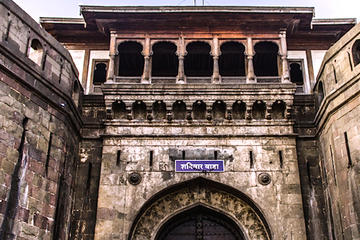
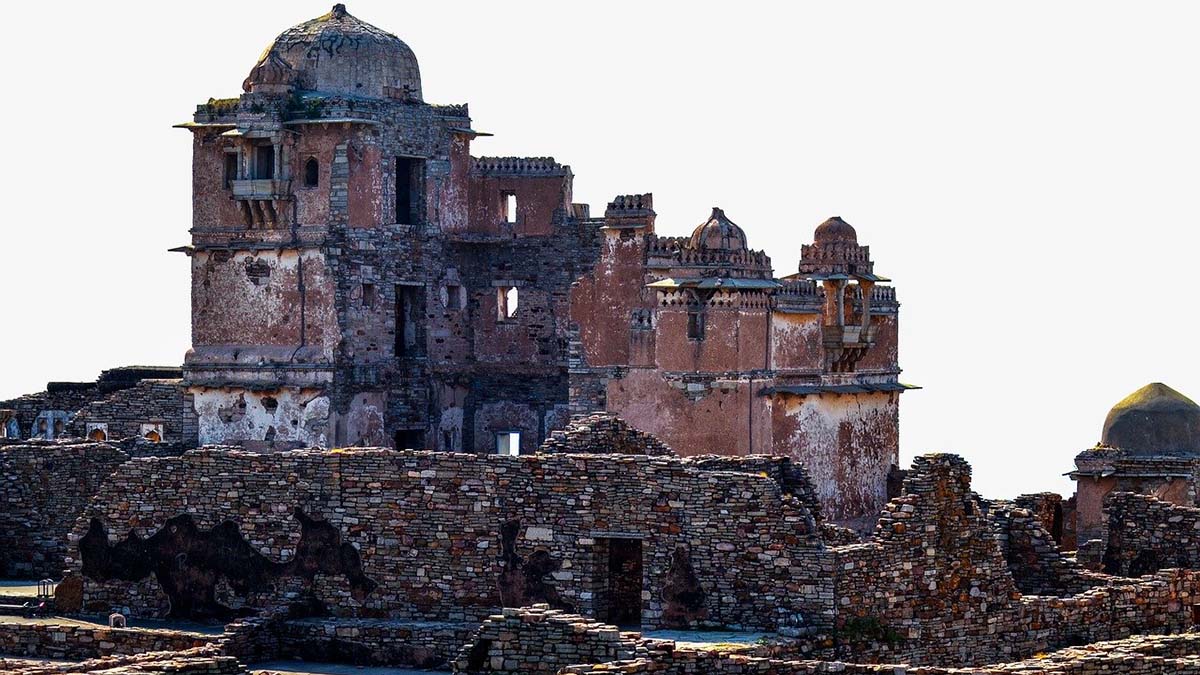
 We stand at the edge of a huge clearing. At one end is a temple, an ancient one, built centuries ago, broken but re-built time and again. All around us are fragments of carved stones. They once adorned temples built around the clearing, and are now waiting to be replaced and returned to at least a shadow of their former glory. The clearing itself is not empty. There are remnants of a huge platform, and some smaller ones. Each one had a role to play in history – a history I have grown up hearing, which has brought me all this way. The story is stuff that legends are made of, and I wanted to see for myself what it felt like to stand at a place where thousands and thousands of women had sacrificed their lives, and the lives of their families, for their honour, and for the honour of their clan. As I stand there, oblivious to the tourists who throng the place, I can’t help but feel the devastation and the sadness that lingers on, centuries after the events have taken place. We are at Chittorgarh, also called Chittaur, in Rajasthan, one of the oldest and biggest forts in India. It was once the bastion of the Mewar Rajputs and was ruled by various kings famed for their courage, but more than them, it is the story of their women that dwells in people’s hearts even today. Not just one woman, but many. There are some whose names we know, and many whose we don’t, but each one of them attained immortality in the hearts and minds of Indians. This is the story of some of these women.
We stand at the edge of a huge clearing. At one end is a temple, an ancient one, built centuries ago, broken but re-built time and again. All around us are fragments of carved stones. They once adorned temples built around the clearing, and are now waiting to be replaced and returned to at least a shadow of their former glory. The clearing itself is not empty. There are remnants of a huge platform, and some smaller ones. Each one had a role to play in history – a history I have grown up hearing, which has brought me all this way. The story is stuff that legends are made of, and I wanted to see for myself what it felt like to stand at a place where thousands and thousands of women had sacrificed their lives, and the lives of their families, for their honour, and for the honour of their clan. As I stand there, oblivious to the tourists who throng the place, I can’t help but feel the devastation and the sadness that lingers on, centuries after the events have taken place. We are at Chittorgarh, also called Chittaur, in Rajasthan, one of the oldest and biggest forts in India. It was once the bastion of the Mewar Rajputs and was ruled by various kings famed for their courage, but more than them, it is the story of their women that dwells in people’s hearts even today. Not just one woman, but many. There are some whose names we know, and many whose we don’t, but each one of them attained immortality in the hearts and minds of Indians. This is the story of some of these women. Padmini was the queen of Rana Ratan Singh, who ruled Chittaur around 1303 AD. She was rumored to be among the most beautiful women in the world. The rumor reached the ears of Sultan Allaudin Khilji, who then ruled Delhi. He attacked Chittaur at once, hoping to add Padmini to his harem. Chittaur however was invincible, and Khilji found himself at the losing end, so he resorted to trickery. He convinced Ratan Singh that all he wanted was a glimpse of the beautiful queen, and that he would leave immediately. The kindhearted Rana agreed, and an ingenious system of mirrors was designed so that Khilji could see Padmini’s reflection in a mirror without setting his eyes on her directly. (The Rajput women were never allowed to be seen by men!) Khilji had no intention of leaving empty handed. He captured the Rana who, with true Rajput hospitality, had gone to the fort entrance to send him off. The queen however, wasn’t just beautiful. She also had brains. She agreed to go to the Sultan, but instead sent her guards in disguise, who succeeded in releasing the Rana. However, by now, the Sultan’s army was at the gates of Chittaur, and defeat was imminent.
Padmini was the queen of Rana Ratan Singh, who ruled Chittaur around 1303 AD. She was rumored to be among the most beautiful women in the world. The rumor reached the ears of Sultan Allaudin Khilji, who then ruled Delhi. He attacked Chittaur at once, hoping to add Padmini to his harem. Chittaur however was invincible, and Khilji found himself at the losing end, so he resorted to trickery. He convinced Ratan Singh that all he wanted was a glimpse of the beautiful queen, and that he would leave immediately. The kindhearted Rana agreed, and an ingenious system of mirrors was designed so that Khilji could see Padmini’s reflection in a mirror without setting his eyes on her directly. (The Rajput women were never allowed to be seen by men!) Khilji had no intention of leaving empty handed. He captured the Rana who, with true Rajput hospitality, had gone to the fort entrance to send him off. The queen however, wasn’t just beautiful. She also had brains. She agreed to go to the Sultan, but instead sent her guards in disguise, who succeeded in releasing the Rana. However, by now, the Sultan’s army was at the gates of Chittaur, and defeat was imminent. Amidst stories of war and death is another story – that of a young girl who came to Chittaur in the 1500s as a bride. She was married to the prince, but refused to accept him as her husband. She was mentally wed to Lord Krishna and her life was dedicated to Him. She spent her time singing songs in praise of the Lord, and talked to Him as if He was present in flesh and blood. This was Meera – the poetess-saint, whose songs on Krishna are sung across the country even today. Her attitude was never appreciated, and after her husband was killed in war, the situation only worsened. She was continually troubled and insulted, until at last, she decided to leave Chittaur and go to the land of her Lord – Mathura and Brindavan. With the departure of Meera, Chittaur seemed to lose its greatness. The locals till today believe that it was Chittaur’s treatment of Meera that instigated the ultimate defeat and destruction of the once-invincible fort!
Amidst stories of war and death is another story – that of a young girl who came to Chittaur in the 1500s as a bride. She was married to the prince, but refused to accept him as her husband. She was mentally wed to Lord Krishna and her life was dedicated to Him. She spent her time singing songs in praise of the Lord, and talked to Him as if He was present in flesh and blood. This was Meera – the poetess-saint, whose songs on Krishna are sung across the country even today. Her attitude was never appreciated, and after her husband was killed in war, the situation only worsened. She was continually troubled and insulted, until at last, she decided to leave Chittaur and go to the land of her Lord – Mathura and Brindavan. With the departure of Meera, Chittaur seemed to lose its greatness. The locals till today believe that it was Chittaur’s treatment of Meera that instigated the ultimate defeat and destruction of the once-invincible fort!
 Years passed, and once again Chittaur was invaded – this time by the Shah of Gujarat, in 1535. The Rajputs were not strong enough, and Queen Karnavati this time decided to take matters into her own hands. She sent an emissary to Humayun, the new Mughal ruler of Delhi, with a fragment of her sari as a ‘Rakhi’ – a thread tied by a woman to her brother, which binds them together. When a woman ties a Rakhi to her brother, he promises to protect her, and it was this protection that Rani Karnavati asked for, from Humayun. Most of Humayun’s supporters were against his going to help a Rajput on the grounds of religion. It took Humayun some time to convince them, but he marched towards Chittaur to help the queen. However, the argument had delayed him by just a day. Sensing defeat at the hands of the enemy and disappointed at the lack of response from Delhi, the queen had taken the path of her ancestor. The funeral pyre had been lit again in the huge clearing near the temple, and the queen had entered it along with all her women. Humayun was too late to save them, and it is said that he felt deeply for not being able to protect his sister. It is said that he continued to wage war against the Shah, and eventually succeeded in defeating him.
Years passed, and once again Chittaur was invaded – this time by the Shah of Gujarat, in 1535. The Rajputs were not strong enough, and Queen Karnavati this time decided to take matters into her own hands. She sent an emissary to Humayun, the new Mughal ruler of Delhi, with a fragment of her sari as a ‘Rakhi’ – a thread tied by a woman to her brother, which binds them together. When a woman ties a Rakhi to her brother, he promises to protect her, and it was this protection that Rani Karnavati asked for, from Humayun. Most of Humayun’s supporters were against his going to help a Rajput on the grounds of religion. It took Humayun some time to convince them, but he marched towards Chittaur to help the queen. However, the argument had delayed him by just a day. Sensing defeat at the hands of the enemy and disappointed at the lack of response from Delhi, the queen had taken the path of her ancestor. The funeral pyre had been lit again in the huge clearing near the temple, and the queen had entered it along with all her women. Humayun was too late to save them, and it is said that he felt deeply for not being able to protect his sister. It is said that he continued to wage war against the Shah, and eventually succeeded in defeating him. The Rajputs were now dwindling. There were just a few who had escaped the wars, and none had the stature and power of their ancestors. Petty jealousies and greed ruled many of the scions of the dynasty. One such scion was Banbir, who killed his brother in order to become the king. Drunk with power, he attempted to kill the crown prince Udai Singh, then an infant. News travels fast, but bad news faster, and the prince’s nurse heard of the impending calamity. A quick thinking and courageous woman, she bundled the prince into a basket of flowers, handed it to a maid and asked her to carry it out of the fort. She then placed her own son dressed in the prince’s clothes on the royal bed, and waited for the traitor. Intent on saving the prince, she watched as her son was killed, cremated him, and then walked out of the fort, taking the prince to safety. History tells us that her name was Panna Dai (Dai means nursemaid), but that is all we know of the woman who gave up her own son to protect the prince.
The Rajputs were now dwindling. There were just a few who had escaped the wars, and none had the stature and power of their ancestors. Petty jealousies and greed ruled many of the scions of the dynasty. One such scion was Banbir, who killed his brother in order to become the king. Drunk with power, he attempted to kill the crown prince Udai Singh, then an infant. News travels fast, but bad news faster, and the prince’s nurse heard of the impending calamity. A quick thinking and courageous woman, she bundled the prince into a basket of flowers, handed it to a maid and asked her to carry it out of the fort. She then placed her own son dressed in the prince’s clothes on the royal bed, and waited for the traitor. Intent on saving the prince, she watched as her son was killed, cremated him, and then walked out of the fort, taking the prince to safety. History tells us that her name was Panna Dai (Dai means nursemaid), but that is all we know of the woman who gave up her own son to protect the prince. Chittaur’s fortunes were declining. The year was 1567 and this time, it was Akbar, Humayun’s son, who invaded Chittaur, in an attempt to bring the land of Mewar under his rule. By this time, it was apparent to all that the fort was no longer invincible, and it was time to move. This time, the prince was convinced to escape and find another place to establish his kingdom, while the rest of the army turned once again towards the last resort – Jauhar and saka. Once again, (thankfully, for the last time), the women ascended the pyre and the men fought with a vengeance, earning the reluctant admiration of Akbar himself. Akbar won the fort, but never ruled it. He took back with him some of the most beautiful things in the fort – its door, a huge drum, and such other things – as mementos of the war, but he never ruled over the fort, which was soon abandoned, and slipped into the misty realm of history.
Chittaur’s fortunes were declining. The year was 1567 and this time, it was Akbar, Humayun’s son, who invaded Chittaur, in an attempt to bring the land of Mewar under his rule. By this time, it was apparent to all that the fort was no longer invincible, and it was time to move. This time, the prince was convinced to escape and find another place to establish his kingdom, while the rest of the army turned once again towards the last resort – Jauhar and saka. Once again, (thankfully, for the last time), the women ascended the pyre and the men fought with a vengeance, earning the reluctant admiration of Akbar himself. Akbar won the fort, but never ruled it. He took back with him some of the most beautiful things in the fort – its door, a huge drum, and such other things – as mementos of the war, but he never ruled over the fort, which was soon abandoned, and slipped into the misty realm of history. The stories are not new to me. I have grown up with them. But standing at the edge of that clearing seems to make them seem more real. On one side is the temple dedicated to the Lord of destruction – Shiva – undoubtedly a fit location for such a temple. On the other side, a little farther away, I can see the spire of the temple of Krishna – the protector – where Meera spent her days in prayer. I can almost imagine the massive funeral pyre and the tongues of flames eagerly lapping up the human sacrifice, of cries rending the air, and the complete stillness at the end, the ground covered in ashes. I can’t help wondering about these women – women who had jumped into the fire, who had been ready to give up everything for what they believed, who sacrificed not just themselves, but their nearest and dearest ones, for the cause they believed in. What kind of women were these? Was it bravery or escapism of the extreme kind? What would have been their thoughts? Ballads have been written about these women, but I know that I will never know the answers to my questions. As we move towards the other parts of the fort, I turn back one last time, for one last look, committing every inch to memory. The women surely deserve that.
The stories are not new to me. I have grown up with them. But standing at the edge of that clearing seems to make them seem more real. On one side is the temple dedicated to the Lord of destruction – Shiva – undoubtedly a fit location for such a temple. On the other side, a little farther away, I can see the spire of the temple of Krishna – the protector – where Meera spent her days in prayer. I can almost imagine the massive funeral pyre and the tongues of flames eagerly lapping up the human sacrifice, of cries rending the air, and the complete stillness at the end, the ground covered in ashes. I can’t help wondering about these women – women who had jumped into the fire, who had been ready to give up everything for what they believed, who sacrificed not just themselves, but their nearest and dearest ones, for the cause they believed in. What kind of women were these? Was it bravery or escapism of the extreme kind? What would have been their thoughts? Ballads have been written about these women, but I know that I will never know the answers to my questions. As we move towards the other parts of the fort, I turn back one last time, for one last look, committing every inch to memory. The women surely deserve that.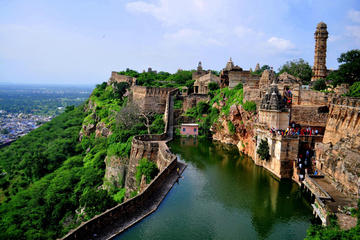

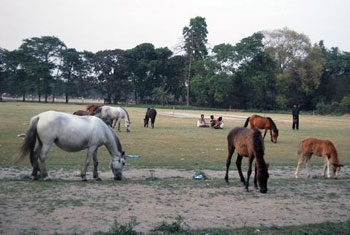 Kolkata is best seen from the footpath. A walk around these streets is a constant zigzag from the denoted path back onto the street to avoid the myriad obstacles of shopkeeper’s and vendors who occupy almost every square inch. The footpaths can be landmines filled with unstable bricks and others simply dug up with no discernable pattern, despite all this around every corner is the time honoured tradition of boys playing cricket. Street children, millions of homeless, goats, cows and other assorted stray animals all fill the footpaths in hopes of finding a new life. With so many people jostling for space it is hard to imagine how these people live and survive. However one of Kolkata’s reputations is correct, it is a shock to the senses. Fittingly it has long been described by many as a “Gateway to the East.” Nothing it seems could be further from our daily routine.
Kolkata is best seen from the footpath. A walk around these streets is a constant zigzag from the denoted path back onto the street to avoid the myriad obstacles of shopkeeper’s and vendors who occupy almost every square inch. The footpaths can be landmines filled with unstable bricks and others simply dug up with no discernable pattern, despite all this around every corner is the time honoured tradition of boys playing cricket. Street children, millions of homeless, goats, cows and other assorted stray animals all fill the footpaths in hopes of finding a new life. With so many people jostling for space it is hard to imagine how these people live and survive. However one of Kolkata’s reputations is correct, it is a shock to the senses. Fittingly it has long been described by many as a “Gateway to the East.” Nothing it seems could be further from our daily routine.
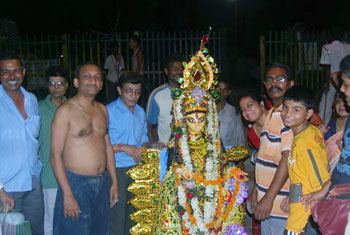 We get off from the beautifully tiled Metro platform and see one of ubiquitous scales that are located at train and metro stations across India. These scales are run by various companies around the country and could remind one of an old style jukebox. The customer steps up onto the scale and for the price of two rupees is treated some snapping neon Christmas-like lights with a bit of music and finally a piece of paper with your weight and a horoscope emerges. Sometimes in place of a horoscope advice is given directly from a Bollywood star! I vowed to use one on our return trip.
We get off from the beautifully tiled Metro platform and see one of ubiquitous scales that are located at train and metro stations across India. These scales are run by various companies around the country and could remind one of an old style jukebox. The customer steps up onto the scale and for the price of two rupees is treated some snapping neon Christmas-like lights with a bit of music and finally a piece of paper with your weight and a horoscope emerges. Sometimes in place of a horoscope advice is given directly from a Bollywood star! I vowed to use one on our return trip. We passed arrays of food vendors, shops selling all types of wooden furniture and famous Bengali sweet shops. Finding a jeweler was proving to be harder than we thought. We wandered some more and turned around and tried to find street signs, which isn’t the easiest task anywhere in India. We asked for directions which resulted in us getting more turned around. This is where India can be its most infuriating, its at these moment where the tropical heat and horns blaring and the roundabout footpaths can make you question your sanity. We finally found a street that was studded jewellers and darted into one.
We passed arrays of food vendors, shops selling all types of wooden furniture and famous Bengali sweet shops. Finding a jeweler was proving to be harder than we thought. We wandered some more and turned around and tried to find street signs, which isn’t the easiest task anywhere in India. We asked for directions which resulted in us getting more turned around. This is where India can be its most infuriating, its at these moment where the tropical heat and horns blaring and the roundabout footpaths can make you question your sanity. We finally found a street that was studded jewellers and darted into one. The shop wasn’t your typical jeweller but more like a junk/trinket store. The shop was owned by a vivacious Bengali man and his son. It looked like it had been there during the days of the original banyan tree. Instead of pulling out any particular rings the owner pulled up several big red boxes while the son turned around and grabbed a silver tray filled with miscellaneous junk. It took several attempts to make ourselves understood about what exactly we wanted done.
The shop wasn’t your typical jeweller but more like a junk/trinket store. The shop was owned by a vivacious Bengali man and his son. It looked like it had been there during the days of the original banyan tree. Instead of pulling out any particular rings the owner pulled up several big red boxes while the son turned around and grabbed a silver tray filled with miscellaneous junk. It took several attempts to make ourselves understood about what exactly we wanted done. He seemed to warm to us and expressed gratefulness to be able practice his English, which wasn’t as bad as we originally thought. Along with being a shop keeper he seemed a very well cultured man and regaled with quotes about his heroes and favourite music.
He seemed to warm to us and expressed gratefulness to be able practice his English, which wasn’t as bad as we originally thought. Along with being a shop keeper he seemed a very well cultured man and regaled with quotes about his heroes and favourite music.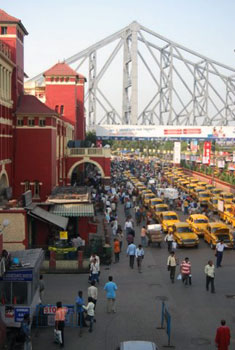 We begged him to sing us a song, a real Bengali song. He refused. We begged more, we asked him how a beautiful man with a beautiful voice could not sing us such a song for our wedding.
We begged him to sing us a song, a real Bengali song. He refused. We begged more, we asked him how a beautiful man with a beautiful voice could not sing us such a song for our wedding.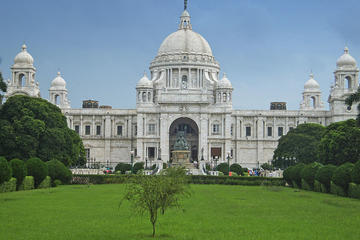
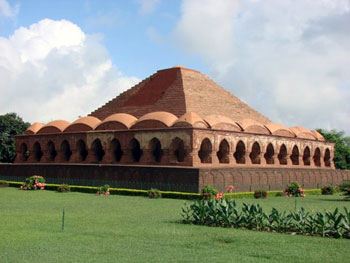
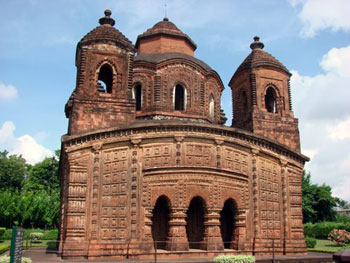 This region was ruled by the Malla dynasty from 8th CE to 19th CE, more than 1000 years and 55 generations. Now there are not many dynasties that have ruled for that long. The origin of the dynasty though lies outside Bengal, in distant Rajasthan from where the first king landed here and sowed the seeds for this dynasty. The dynasty was Shaivaite i.e the worshippers of Shiva, one of the Gods in famous Indian Trinity of Brahma, Vishnu, Mahesh aka Shiva. During the early 17th century, kingdom was under king Bir Hambir. He converted to Vaishanava sect and became a devotee of Vishnu. Ram and Krishna are two popular incarnations of Vishnu. He started building temples for his new faith. Most of the temples are dedicated to Krishna and his beloved Radha. Temples are names after various names of these deities. The terracotta was chosen as the base material for the temple, as there is no native stone in this region, so they had to depend on the clay that is amply available. Unfortunately the life of Terracotta is 300-400 years and you can see the corrosion that has already started happening in the temple tiles.
This region was ruled by the Malla dynasty from 8th CE to 19th CE, more than 1000 years and 55 generations. Now there are not many dynasties that have ruled for that long. The origin of the dynasty though lies outside Bengal, in distant Rajasthan from where the first king landed here and sowed the seeds for this dynasty. The dynasty was Shaivaite i.e the worshippers of Shiva, one of the Gods in famous Indian Trinity of Brahma, Vishnu, Mahesh aka Shiva. During the early 17th century, kingdom was under king Bir Hambir. He converted to Vaishanava sect and became a devotee of Vishnu. Ram and Krishna are two popular incarnations of Vishnu. He started building temples for his new faith. Most of the temples are dedicated to Krishna and his beloved Radha. Temples are names after various names of these deities. The terracotta was chosen as the base material for the temple, as there is no native stone in this region, so they had to depend on the clay that is amply available. Unfortunately the life of Terracotta is 300-400 years and you can see the corrosion that has already started happening in the temple tiles.
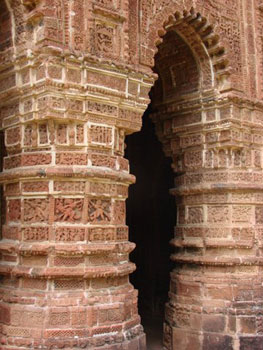 Rasamancha is a unique structure in Bishnupur, again built by Bir Hambir in 1600 CE. It is a pyramid like structure on a huge square platform. The circumambulate corridors have huge arches with lotus motifs, that create a labyrinth like way to the central point, where probably a deity was worshipped. It is a place that was used for a local festival called Rasa festival. During this festival all the images from temples of neighboring villages were brought here and displayed in these galleries for the public. The festival still continues to be celebrated here but probably in a more contemporary way. It is said that it is one of its kind structure in the world and no parallel or a similar structure has been found anywhere.
Rasamancha is a unique structure in Bishnupur, again built by Bir Hambir in 1600 CE. It is a pyramid like structure on a huge square platform. The circumambulate corridors have huge arches with lotus motifs, that create a labyrinth like way to the central point, where probably a deity was worshipped. It is a place that was used for a local festival called Rasa festival. During this festival all the images from temples of neighboring villages were brought here and displayed in these galleries for the public. The festival still continues to be celebrated here but probably in a more contemporary way. It is said that it is one of its kind structure in the world and no parallel or a similar structure has been found anywhere. Artisans of Bishnupur and around excel in the metal craft. They make various items of decorative as well as everyday use in brass. The art form resembles the tribal art from other tribal regions of India. The artists still make the metal ware with the lost wax method, which is the oldest known way of making metal ware. Look for conch shell bangles that are hand carved in tiny shops on both sides of narrow lanes along with the carved conch shells that look beautiful. You can also shop for the Ganjifa cards that are the origin of modern day playing cards and are now hand made by only one family here, the Fauzdar family. If you get a chance, indulge yourself in the classical music that belongs to the gharana or tradition of this town.
Artisans of Bishnupur and around excel in the metal craft. They make various items of decorative as well as everyday use in brass. The art form resembles the tribal art from other tribal regions of India. The artists still make the metal ware with the lost wax method, which is the oldest known way of making metal ware. Look for conch shell bangles that are hand carved in tiny shops on both sides of narrow lanes along with the carved conch shells that look beautiful. You can also shop for the Ganjifa cards that are the origin of modern day playing cards and are now hand made by only one family here, the Fauzdar family. If you get a chance, indulge yourself in the classical music that belongs to the gharana or tradition of this town.

